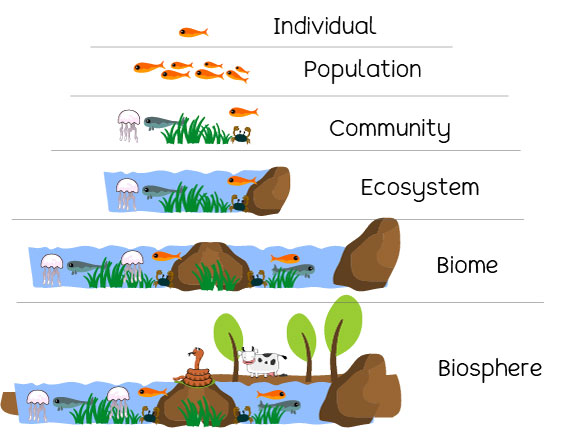- Ecosystems
Levels of organization in an ecosystem
To understand the levels of belonging in an ecosystem, let us consider the diagram below.

Individual, Species, Organism:
An individual is any living thing or organism. Individuals do not breed with individuals from other groups. Animals, unlike plants, tend to be very definite with this term because some plants can crossbreed with other fertile plants.
In the diagram above, you will notice that Gill, the goldfish, is interacting with its environment, and will only crossbreed with other goldfish just like her.
Population:
A group of individuals of a given species that live in a specific geographic area at a given time. (an example is Gill, her family, friends, and other fish of Gill’s species) Note that populations include individuals of the same species, but may have different genetic makeup such as hair/eye/skin color and size between themselves and other populations.
Community:
It includes all the populations in a specific area at a given time. A community includes populations of organisms of different species. In the diagram above, note how populations of goldfish, salmons, crabs, and herrings coexist in a defined location. A great community usually includes biodiversity.
Ecosystem:
As explained in the pages earlier, ecosystems include more than a community of living organisms (biotic) interacting with the environment (abiotic). At this level, note how they depend on other abiotic factors such as rocks, water, air, and temperature.
Biome:
A biome, in simple terms, is a set of ecosystems sharing similar characteristics with their abiotic factors adapted to their environments.
Biosphere:
When we consider all the different biomes, each blending into the other, with all humans living in many different geographic areas, we form a huge community of humans, animals plants, and micro-organisms in their defined habitats. A biosphere is the sum of all the ecosystems established on planet Earth. It is the living (and decaying) component of the earth system.
